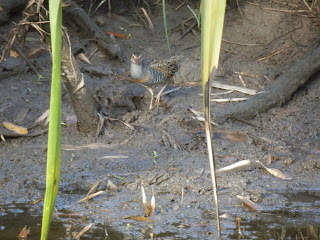As the sun rises over the Johnston River the warm air activities the night's fog and sends it tumbling down the River. Of a morning I like to stand on the river-bank and wait for the fog to reach me and as it does the sounds of the birds in the mangroves, particularly that of the butcher bird, is removed and distorted by the damp fog. As I watch the fog rolls over and out of the River mouth and suddenly evaporates and all is clear again.
Soon I am joined by two juvenile agile wallabies, they recently left their mother's pouch and now have mated up; one is a little older. The wallabies seek out the fresh grass growing on the edge of the River. No one has told them that wallaby is crocodile's favourite breakfast.
Indian Koels arrived this week, or at least it is the first time that I have sighted them.
I saw the male fly into the fig tree and he appeared to plop down exhausted on a low branch. I rushed down with my camera and he was so close I had to ramp back on my zoom in order to get his tail in the photo. For about ten minutes he sat there not moving and then silently he moved higher into the tree to eat the few figs remaining on the tree.
With his tummy full and his strength returned the Koel lifted his head and with a strong clear note triumphantly coo-eeed the announcement of his presence; his dark feathers shining in the early morning sunlight.
On Thursday I heard strange chuckling and coo-ees from some nearby trees. The female Indian Koel had arrived and the male was courting her. She was secluded within the tree branches and seemed annoyed by the male's behaviour.
This morning I heard the koels again and this time in the fig tree where I was able to observe them.
For half an hour he uttered low, hiss like sounds. She totally ignored him. I stood with my arms in the air holding the camera steadily aimed at them waiting for the mating event. They never moved. Eventually she stirred and flew off into another tree her beautifully patterned feathers glistening in the early morning sunlight. Obviously, this time, he was too slow off the mark for her.
The pheasant cocual, although not showing mating plumage, has been vocal of late.
I took this photo about 5.30 pm with the last rays of the sun illuminating cocual's beautiful rufous red wing feathers, how magnificent he looks! In breeding plumage the chest feathers are black.
With the dry weather the level in the sediment pond has fallen and buff-banded rail is easily finding her dinner.
 When Rail moved to the end of the pond I was astonished how well her plumage served her, camouflaged both in brown and grey backgrounds.
When Rail moved to the end of the pond I was astonished how well her plumage served her, camouflaged both in brown and grey backgrounds.
The male lace monitor is wearing his new coat and spends some time every day sunning himself on a coconut tree trunk partly concealed by the thick lichen that is growing on the trunk.
 Powerful legs enable the monitor to climb to the top of trees.
Powerful legs enable the monitor to climb to the top of trees.
Young cassowary 'Dot' visits the old bath in the nursery every day. With the hot, dry weather he is very thirsty and will sit down to drink undisturbed by our activity around him.
Matriarch cassowary 'Jessie' has been interacting with 'Dot' and 'Snout'. 'Snout' showed some interest in 'Jessie' and performed a little dance for her, however, she wasent impressed this time and they are not courting.
The old matriarch 'Peggy' (named after Margaret Peggy Morehouse) is also showing interest in 'Snout' but he is ignoring her.
 'Peggy' has been hanging about 'Snout' and I am waiting for her to have a confrontation with 'Jessie' as it seems inevitable.
'Peggy' has been hanging about 'Snout' and I am waiting for her to have a confrontation with 'Jessie' as it seems inevitable.
I have not seen 'Little Dad' and the chicks this week but the larger of the chicks, we are now calling 'Cheeky', continues to become separated from his father. They walk along the back of the houses on the range and last night 'Checky', who tends to wander away from 'Little Dad', was left behind. Fortunately they reunited some hours later.
The Queensland rain forest creeper Tecomanthe 'Roaring Meg' is again in full flower in the nursery 'dunny'. When I invite people to view my dunny they think I am weird until they see it!
A meeting of the conservation group Cassowary Coast Alliance was held on Wednesday morning at Coquette Point. We were delighted to have the two Margarets, Margaret Thorsborn and Margaret Morehouse in full swing. Reports will soon be available for the Nutmeg Pigeon count and we are working to protect turtle nesting sites and shorebird rookeries.
Margaret M and I went for a walk to the mouth of the Johnston River and I showed Margaret the mangrove dieback on the southern side of the river mouth. The mangrove forest has retreated some 300 metres and is now threatening to erode the dune system. If this happens lot 27V, where the proposed RV park is to go, will be inundated every high tide.
Erosion from Crocodile Creek on the Western side of the rookery-dune will soon break through the neck of the rookery. Crocodile Creek should then shift its mouth to its pre-cyclone 'Larry' position. The southern mouth of the Johnston River is a dynamic system.
The sunsets this week have been particularly lovely.
I hope the sunsets at you place are also lovely.
cheers for now.
Yvonne C.










.JPG)
.JPG)







No comments:
Post a Comment